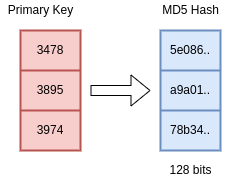Cassandra
Cassandra is a key/value store database. It provides Availablity and Partial Fault Tolerance from the CAP. Cassandra combines the BigTable data model and Dynamo system architecture.
- The database is
NoSQL, wide-column, key-valuelike BigTable. - It’s `key/value store, highly available like Dynamo.
Fully replicated
Cassandra is a fully replicated, highly available, partial fault tolerance database. The data from each node is replicated to other nodes. The number of nodes to which data is replicated is called the replication factor. Generally, the replication factor is 3.
When a client sends a put(K,V) operation
- the data is replicated in the local data center as well as the other data center. The data is replicated on nodes in both the data center.
- replication factor can also be set per data centers

Write
- Client sends
put(K,V)to the node. - The request is written into
commit logfor crash recovery - The values are inserted in the in-memory
memtable - Memtables are periodically flushed to the file system in the form of
SSTables

Write with Partitioning
- For writes, it is necessary that a single node in the cluster is not overwhelmed with write requests, while other nodes are idle.
-
Cassandra maintains a primary key for the table. This primary key determines to which node the write request will be sent. - Each node is assigned a range, for which it stores the data. This node is called
primary. The primary is also responsible for replicating the data to other nodes as per the replication factor. - For consistency and load distribution, the primary key is hashed either using MD5 or murmur3 hash.
- The hashed key is then used with
consistent hashingto determine the node. -
The data is first sent to the primary node and then replicated to other nodesas per the replication factor.



Read
Client can connect to any node in the clusterAll nodes are aware of each other in the clusterAll nodes know which node is responsible for the key range along with its replica- If the client connects to a node that is neither primary nor the replica of primary, the node forwards the read request based on the hashed key to the responsible primary node and its replica

- Node 4 receives the client request for a read
- If node 4 is not responsible for the key range, it is aware that the requested key has primary as node 1
- request is forwarded to node 1 along with the replicas responsible for the key
- node 4 waits for the quorum
- once the quorum is received, it forwards data to the client
Consistency Level
For every read request, read repair is performed. It can be done across data centers as well
-
ONE :
- the data is returned to client from a single node.
- very fast but high probability of stale data
-
QUORUM:
- > 51% replicas ack
- high consistency as there is atleast one single node that has seen the latest write
-
LOCAL QUORUM:
- > 51% replicas ack in local Data Center
-
LOCAL_ONE:
- > read repair only in local Data Center
-
ALL:
- Ack from all nodes
Cassandra combines the Hash and key range. It has a compound primary key, consisting of several columns. The first part is used as input to the hash function, the other part of the key is used to sort the data in the partition.